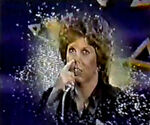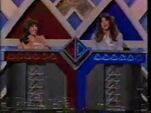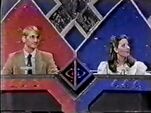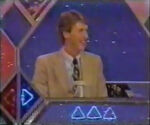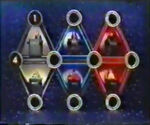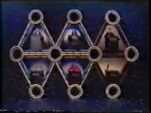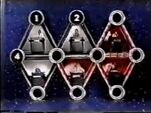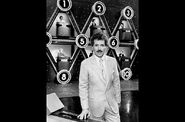| Host | |
| Alex Trebek | |
| Announcers | |
| Rod Roddy (1981–1982) Charlie Tuna (1983) | |
| Broadcast (NBC Daytime) | |
| Battlestars: 10/26/1981 – 4/23/1982The New Battlestars: 4/4/1983 – 7/1/1983 | |
| Packager | |
| Merrill Heatter Productions | |
"(insert shooting sound, identify celebrities). Those are the/All on (The New) Battlestars. And here's the man in command, ALEX TREBEK!"
(The New) Battlestars was an American game show that aired for two separate runs on NBC during the early 1980s.
Battlestars was similar to Hollywood Squares (another Heatter-Quigley Productions game show) in its gameplay and use of multiple celebrities (leading some fans to dub it "The Hollywood Triangles"). The show was produced by Merrill Heatter Productions, Heatter's first show produced without Bob Quigley.
Gameplay
Main Game
Two contestants (one a returning champion) competed. The champion sat at the blue podium and the challenger at the red podium. They faced a six-member celebrity panel, who sat in a large space-like set made up of triangles. Each triangle had three numbers (1-10) attached to their points; hence, they were called "Points of Light" (1-4-5, 2-5-6, 3-6-7, 4-5-8, 5-6-9, and 6-7-10).
The contestant in control pushed a plunger on their podium to stop a flashing randomizer, and the number it stopped on determined which celebrity would be asked a question. The questions on Battlestars were asked in the style of The Hollywood Squares, except that a celebrity was given two possible answers and had to choose between one or the other. Once the celebrity chose his/her answer, the contestant was asked whether they agreed or disagreed with the celebrity. A correct response meant that the contestant kept control. If the contestant was wrong, control passed to their opponent. Regardless of how the contestant in control answered, the Point of Light was lit and it was then taken out of play. However, similar to Hollywood Squares, if a miss would result in the capture of a celebrity to an opponent by default, the Point would remain in play.
When landing on a number on the top or bottom row, the contestant had to play with the celebrity whose triangle touched that number; but when landing on a center row number since they were attached to two or more triangles, the contestant chose which celebrity to play with, although the choice defaulted if it meant a star could be captured (unless of course more than one star could be captured).
If the player in control lit the last Point of Light around a celebrity, even if their opponent was responsible for the other two lights, the player "captured" that star. The first contestant to capture three stars won the game, $500 and played the bonus round. Also, if a contestant managed to capture all six celebrities (a rare feat), they won a bonus prize on the original version and $1,000 on the 1983 revival.
1983 changes
The rules were identical except for these minor changes:
- The object was to extinguish the points of light rather than to light them. This was merely a cosmetic change and had no bearing on the rules.
- The points of light were now extinguished regardless of whether or not the contestant's decision was correct.
- The randomizer was only used when control passed between contestants. Upon getting a correct answer, the contestant in control simply chose a number verbally.
- Finally (and this also had no bearing on the rules), not only the stars saw the displaying of the two answer choices, but the home and studio audience saw them, too. The players in studio did not see them, however, until the bonus game (which will be explained later).
Bonus game
1981-1982: Battlestars Two
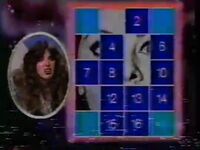
The champion is agonizing over this picture.
A famous celebrity face was completely hidden under 16 numbered blocks. The winning contestant chose three cards which Trebek would put in a scanner on his podium. After the three blocks were removed, the contestant picked one more square that would help them most. On some episodes, the contestant's choice was made prior to drawing the three cards. If a card drawn matched the number of the square the contestant already chose to reveal, the contestant would draw another card. The contestant then had a chance to identify the celebrity for $5,000. For a week of Christmas shows in December 1981, the top prize was doubled to $10,000.
However, if they gave a wrong guess or couldn't answer, the contestant drew up to three additional cards (one at a time) and could solicit help from the celebrities by having them identify the star instead. The prize value dropped to $3,000 for the first card, then $2,000 and $1,000. If the contestant failed to identify the face after these four attempts, the contestant chose another space to reveal and played for $500. Failure to win $500 allowed the player to choose one last space and play for $250. Failure to win the $250 ended the round and won absolutely nothing.
1983: The Main Event/Battlestars Bonanza
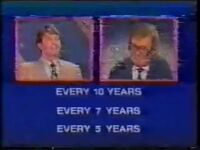
A playing of the revival's Main Event in progress.
The winning contestant and the three captured Battlestars (or three of the contestant's choice if more were captured) played a three-question bonus round. Each multiple-choice question had three possible answers which were now displayed to everybody. After the celebrity in play offered his/her choice, the contestant was asked whether they agreed or disagreed. If the contestant was correct in disagreeing, they had to choose the correct answer from the two remaining choices to win any cash.
The first two questions were played for $500 each. If the contestant answered all three questions correctly they won the "Battlestars Bonanza", a jackpot that started with $5,000 cash and a prize package (generally a combined value of $10,000 or more), with another prize added every time it was not won.
Scheduling/Ratings
NBC scheduled the first version of Battlestars at 11:30 a.m./10:30 Central, replacing Card Sharks and swapping places with Password Plus. However, it became yet another in a long line of victims of CBS' The Price is Right, and NBC pulled it after a six-month run. With the cancellation of Blockbusters on the same day, Wheel of Fortune was left as the sole game on NBC's daytime schedule until January 3, 1983 when Hit Man, Just Men! and a revival of Sale of the Century debuted.
After a retooling, Battlestars returned a year later, at Noon/11 Central following Dream House. Like practically all shows since Jackpot in 1975, though, Battlestars proved no match at all for CBS' The Young and the Restless and ABC's Family Feud, nor was it widely cleared by local stations, which opted to show local news instead.
Rating
Music
Mort Garson
Studio
NBC Studio 3, Burbank, California
Trivia
Jerry Seinfeld appeared as a panelist in 1982. At the time he was a relatively unknown comic working the stand-up circuit.
Alex Trebek became the second person (after Jim Perry) to concurrently host a Canadian and an American game show, as Trebek was hosting Pitfall in Vancouver.
On the 1983 premiere of The New Battlestars, after providing several incorrect answers, panelist Debbie Reynolds jokingly ran out of the studio, screaming and crying at the same time. When the show returned from the commercial break, Trebek quipped that security officers caught Debbie in the hallway, brought her back to the studio and put her back in her seat.
Sound Effects
- The number dancing sound was previously used in a 1979 pilot for a new version of Gambit.
- The capture sound was also used on its companion show Dream House for when the "Golden Circuit Breaker" rises up from Bob Eubanks' part of the podium.
- The sound of a chosen number lighting up and the time's up signal in the picture game, were both later used on Hot Potato. The earlier was also used on Wordplay.
- The end of the show signal was later used as the "Speedword" signal on Scrabble, a show which would replace Dream House.
- All of the shows mentioned also aired on NBC.


